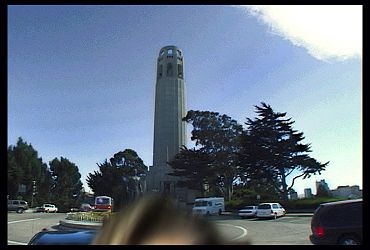The XL1 Watchdog
|
> top of page < |
Posterization (Contouring) Examination
an article by Don Palomaki and others
NOTE: This article is in some ways obsolete and in other ways still relevant. Canon has since determined the "posterization/gradient banding" problem to be an anomaly of quantization, part of DV technology. The proper term for the effect is "contouring." At the time the following piece was written however, there was very little publicly known about the cause of the effect, which led to some speculation which you'll read about here. I've chosen to leave this article intact, primarily because it does a good job of explaining the issue and provides some frame-grabs for visual reference which clearly show the effect. The point is that although the matter has since been addressed by Canon, and the XL1 is exonerated as the cause of the anomaly, this article does a good job of describing the contouring (posterization/banding) effect which users may occasionally stumble onto.
The following information has been compiled by Don Palomaki, Arthur Hancock, Josh Williams and several others; and edited for content by the Watchdog.
The XL1 represents a significant investment for many buyers, but it has its limitations and design trade-offs, as do all camcorders in its price class (which is often referred to as "prosumer"). Prospective buyers are well advised to carefully evaluate the XL1 against their intended uses and needs.
With this in mind, the following summarizes the most widely reported issue with the XL1. Issues related to the user-interface and displays are not listed because they may reflect individual preferences more than manufacturing variances.
The Posterization/Gradient Banding Problem
Perhaps the most serious issue facing XL1 users to date is an image anomaly referred to as "posterization." Some users have reported that under rather specific lighting and subject matter conditions, they have encountered a "gradient banding" or posterization effect in the image. The conditions appear to be a long, uniform, gradual, and noise free gradient background and a sharply contrasting subject, such as a bronze statue against a clear blue sky. The banding appears as if it is the result of digital quantizitation of the image into a limited number of colors or gray scale steps. This matter is currently under review by Canon USA and the parent Canon Corporation in Japan. As soon as the manufacturer officially addresses this issue, it will be posted here. For now, here are three frame grabs which clearly show the anomaly.
The Watchdog has noticed an abundance of usenet traffic speculating on the cause of this problem. There is very little point in doing so since the manufacturer is indeed pursuing the issue. However, until an official announcement is made, there is one post in particular that is worth repeating in entirety here, for the benefit of those who can't wait for the manufacturer's response. Again, what follows is speculation only...
"The banding may be caused by an interaction between digital quantizitation, a long gradual gradient (perhaps with a hot spot), next generation low noise CCD chips, and digital signal processing. This is described below.
"The 8-bit Digital conversion results in distinct bands in a uniform gradient input. As many as 256 bands are possible in about 100 IRE, or about 0.4 IRE per step.
"With a noise-free source, these bands will have a sharp boundry. If the input has some noise, this boundry will be dithered by the noise and will appear as a gradual transition. A noise level of about 1/3 step value (0.13 IRE) might be best.
"If the image is processed to enhance shadow and highlight detail, this this probably means the shadow and highlight gradients are being steepened (and midtones flattened). If this processing is done in the digital domain, it probably means that the the steps in the shadow and lighlight regions are increased from 0.4 IRE to something greater, perhaps in the range of 1 to 2 IRE per step. This would have the effect of making the image look a bit like 7- or 6-bit quantizitation.
"If there is noise or subject texture induced dithering, the larger step created by DSP still has a soft boundry and and a gradient look. However, a sharp step boundry will look even more pronounceed.
"New CCD's and pickup circuitry may well have lower intrinsic noise than the 2-year old designs used in the VX-1000 and AG-EZ1. Remember the notorious VX-1000 noise grain, especially in low-light and/or gain-up shooting conditions.
"Now if you dump this into a receiver with high contrast and and edge enhancement software - it could get ugly. Just a theory to think about while we wait for an official statement from Canon".
The Watchdog adds one last bit of Usenet speculation:
"The fix may be as simple as correcting the voltage going to the CCD unit. Canon may want to consider building a better voltage regulator. It's possible the CCD's signals are being missread because of the fluctuation of the input voltage."Many flatbed scanners did this for a long time, and the fix was to regulate the lamp voltage, and other manufacturers chose to leave the lamp on when in non scan mode. This caused the temperature to remain constant (more constant than an off-to-on state... the rise in heat in a semi-conductor causes a decrease in resistance resulting in more current flow thus changing the value of the signal that the CCD picked up).
"The banding/moire effect might be cured by building a better voltage regulator. The reason some systems seem to do it and others don't is the result of the tolerance of the components themselves."
The Watchdog notes: During my April 6th conversation with Joe Bogacz, Canon USA's Director of Video Technology, he remarked that the speculation about the voltage regulator having an influence on this matter was absolutely correct. "I made a point to check on the voltage regulators being used in the XL1 assembly," he said. "I was assured that for the exact reasons stated in your articles, the specific voltage regulator chosen for the XL1 is unquestionably the best available."
Back to the XL1 Articles Menu
Thrown together by Chris Hurd
Please direct questions to the DV Info Net Community Forums.
Where to Buy: These dealers are authorized DV Info Net sponsors... | |||
|
|
|
|
|
|
|
|
Please support this site by making your purchases through them. Thanks! | |||
©1998-2008 DV Info Net
The Digital Video Information Network
San Marcos, Texas
Paint your wagon.


